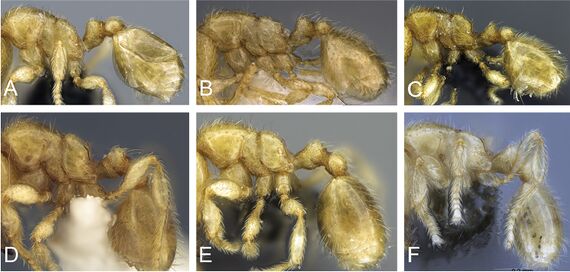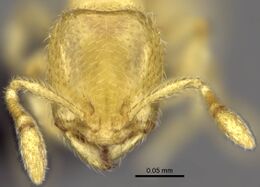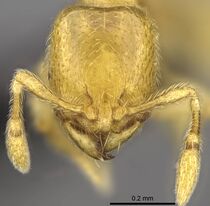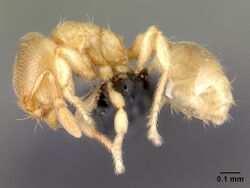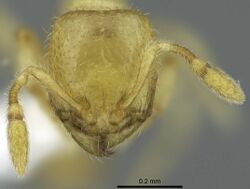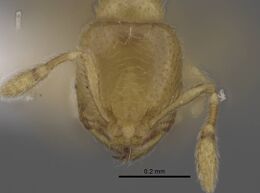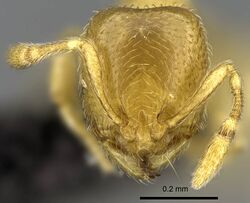Key to Malagasy Carebara minors
This key to minor workers is based on: Azorsa, F., Fisher, B.L. 2018. Taxonomy of the ant genus Carebara Westwood (Formicidae, Myrmicinae) in the Malagasy Region. ZooKeys. 767:1–149. (doi: 10.3897/zookeys.767.21105).
They included the following discussion about worker polymorphism, and it is quite useful to read this before you begin to use this key:
Most Carebara species from the Malagasy Region show a remarkable range of morphological diversity, and this is especially noticeable in the major worker subcaste. In some cases, like Carebara jajoby, and Carebara nosindambo, there are four recognizable “intermediates” in the major worker subcaste (from the smallest, intermediate 1, to the largest, intermediate 4) in the same colony. Morphologically these intermediates are mosaics between major workers and queens.
The main variations present in the intermediates from the smallest to the largest are: a) posterolateral corners of head: moderately to strongly expanding posteriorly; b) posterior margin of head: weakly to strongly concave; c) size of the eyes: in some species from one to 75 ommatidia; d) number of ocelli: from one to three; e) form of the mesosoma: showing remnants of queen flight sclerites; f ) propodeal spiracle: distance of propodeal spiracle to declivity of propodeum closer to midlength of propodeal sclerite in larger intermediates; g) hair abundance; and h) sculpture: weakly to strongly sculptured.
All the variations present in the intermediates were included in the identification key, and can be separated using the major worker key. In some cases, larger intermediates are similar in the form of the head, but they differ in the form of the propodeum, petiole, as well as in the pilosity, so the user should check all characters mentioned on each part of the key.
There is a diagnosis of Malagasy Carebara workers at the bottom of this page and a webpage with a Key to Malagasy Carebara majors
You may also be interested in
1
- Antennae 9-segmented . . . . . 2
- Antennae 10- or 11-segmented . . . . . 3
2
return to couplet #1
- Head somewhat longer (HL 0.39–0.49), with the dorsum smooth (Fig. 20A) . . . . . Carebara grandidieri
- Head somewhat shorter (HL 0.31–0.33), with the dorsum sculptured (Fig. 20B) . . . . . Carebara creolei
3
return to couplet #1
- Head and mesosoma with abundant erect and suberect, long and short hairs, more than 25 hairs on posterior margin of head, and more than 32 hairs on dorsal face of mesosoma; in profile, posterodorsal corner of propodeum convex and unarmed; petiolar node thick, petiole and postpetiole with abundant erect and suberect hairs (Fig. 21B, C) . . . . . 4
- Head and mesosoma with few decumbent to erect, long and short hairs, with fewer than 20 hairs on posterior margin of head, and fewer than 25 hairs on dorsal face of mesosoma; in profile, posterodorsal corner of propodeum armed with at least a dentiform angle or with a distinct triangular tooth, or if propodeum convex and unarmed then with less than 6 long erect hairs on mesosoma; petiole and postpetiole with few subdecumbent to apressed hairs (Fig. 21A) . . . . . 5
4
return to couplet #3
- Dorsum of propodeum nearly flat; mesosoma somewhat longer (WL 0.50– 0.57); distance from center of propodeal spiracle to posterodorsal corner of propodeum relatively large (PSL 0.03–0.04); mandible length relatively large (MI 27–31) (Fig. 22A) . . . . . Carebara hiragasy
- Dorsum of propodeum slightly convex; mesosoma somewhat shorter (WL 0.45–0.47); distance from center propodeal spiracle to posterodorsal corner of propodeum short (PSL 0.02–0.03); mandible length relatively short (MI 15–24) (Fig. 22B) . . . . . Carebara placida
5
return to couplet #3
- In profile, posterodorsal corner of propodeum evenly convex and unarmed, without trace of a prominent dentiform angle or tooth (Fig. 23A) . . . . . Carebara malagasy
- In profile, posterodorsal corner of propodeum armed with at least a dentiform angle, or with a distinct triangular tooth (Fig. 23B, C, D) . . . . . 6
6
return to couplet #5
- In profile, posterodorsal corner of propodeum at least with a dentiform angle, more usually the corner with a pair of small, low, angulate teeth (Fig. 23B, C) . . . . . 7
- In profile, posterodorsal corner of propodeum armed with a conspicuous pair of triangular teeth (Fig. 23D) . . . . . 11
7
return to couplet #6
- In profile, combined outline of dorsal surface of peduncle and anterior face of node weakly concave, and outline of dorsal surface of propodeum weakly concave (Fig. 24B) . . . . . Carebara demeter
- In profile, combined outline of dorsal surface of peduncle and anterior face of node flat; outline of dorsal surface of propodeum flat, or weakly convex and declining posteriorly (Fig. 24C, D, E, F) . . . . . 8
8
return to couplet #7
- In profile, outline of dorsal surface of propodeum flat and declining posteriorly at about 40 degrees compared to the ventral margin of the metapleura; posterodorsal corner of propodeum angulate or with a pair of laminate triangular teeth, directed upward (Fig. 24D) . . . . . Carebara dota
- In profile, outline of dorsal surface of propodeum convex or weakly convex and declining posteriorly at about 30 degrees compared to the ventral margin of the metapleura, posterodorsal corner of propodeum at least with a dentiform angle (Fig. 24C, E, F) . . . . . 9
9
return to couplet #8
- In profile, gaster with few short decumbent to subdecumbent hairs and long subdecumbent hairs; petiolar node relatively low (PTH 0.09–0.10) (Fig. 24E) . . . . . Carebara bara
- In profile, gaster with abundant subdecumbent hairs; petiolar node relatively high (PTH 0.11–0.12) (Fig. 24C, F) . . . . . 10
10
return to couplet #9
- In profile, distance from propodeal spiracle nearly close to declivity, less than half the diameter of the spiracle; petiolar node relatively narrow; declivity of propodeum weakly concave; gaster with more than 30 subdecumbent hairs (Fig. 24C) . . . . . Carebara betsi
- In profile, distance from propodeal spiracle to declivity about half the diameter of the spiracle; petiolar node not narrowed; declivity of propodeum weakly convex; gaster with fewer than 25 subdecumbent hairs (Fig. 24F) . . . . . Carebara tanana
11
return to couplet #6
- In profile, dorsum of propodeum and declivity convex or weakly convex (Fig. 25A, B, C, D) . . . . . 12
- In profile, dorsum of propodeum and declivity flat or concave (Fig. 25E, F, G, H) . . . . . 16
12
return to couplet #11
- In profile, combined outline of dorsal surface of peduncle and anterior face of node nearly straight; gaster with short appressed hairs, and without longer decumbent, suberect or erect hairs; propodeal teeth acutely triangular and slightly longer than propodeal spiracle diameter; petiolar node smooth and shiny (Fig. 26A) . . . . . Carebara mahafaly
- In profile, combined outline of dorsal surface of peduncle and anterior face of node medially concave; gaster with long subdecumbent to suberect hairs, and short appressed or decumbent hairs; propodeal teeth short, weakly triangular, and not as long as propodeal spiracle diameter; petiolar node sculptured (Fig. 26B) . . . . . 13
13
return to couplet #12
- Hairs of the scape, posterior margin and lateral margins of head, abundant and subdecumbent; dorsum of promesonotum with abundant short suberect hairs (20–30 hairs); distance from center of the propodeal spiracle to declivity same or slightly longer than the diameter of the spiracle (Fig. 27A) . . . . . Carebara salegi
- Hairs of the scape, posterior margin and lateral margins of head, decumbent or appressed; dorsum of promesonotum with short subdecumbent to suberect hairs (fewer than 20 hairs); distance from center of the propodeal spiracle to declivity less than the diameter of the spiracle (Fig. 27B, C, D) . . . . . 14
14
return to couplet #13
- Dorsum of propodeum weakly convex; posterodorsal corner with a pair of very short triangular teeth, length less than propodeal spiracle diameter (Fig. 28A) . . . . . Carebara lova
- Dorsum of propodeum convex; posterodorsal corner of propodeum with a pair of triangular and laminate teeth, length same as propodeal spiracle diameter . . . . . 15
15
return to couplet #14
- Anterodorsal corner of petiole convex; side of propodeum areolate-rugose, propodeal lobes subtriangular and obtusely rounded; gaster with short decumbent to appressed hairs and long subdecumbent hairs (Fig. 28B) . . . . . Carebara omasi
- Anterodorsal corner of petiole rounded; median area of side of propodeum smooth and shining, propodeal lobes short and convex; gaster with short decumbent to subdecumbent hairs and long subdecumbent to suberect hairs (Fig. 28C) . . . . . Carebara nosindambo
16
return to couplet #11
- In profile, declivity of propodeum concave to weakly concave (Fig. 28D, F) . . . . . 17
- In profile, declivity of propodeum flat (Fig. 28G) . . . . . 20
17
return to couplet #16
- Gaster with short decumbent to subdecumbent hairs and long subdecumbent to suberect hairs, lateropropodeum almost smooth and shiny (Fig. 28D) . . . . . 18
- Gaster with short appressed to decumbent hairs and long subdecumbent hairs, lateropropodeum sculptured (Fig. 28F) . . . . . 19
18
return to couplet #17
- Gaster with short subdecumbent to decumbent hairs, and more than ten longer subdecumbent or suberect hairs; distance from propodeal spiracle to declivity less than the diameter of the spiracle (Fig. 28H) . . . . . Carebara tana
- Gaster with abundant subdecumbent hairs, and with fewer than ten longer suberect hairs; distance from propodeal spiracle to declivity same as the diameter of the spiracle (Fig. 28E) . . . . . Carebara jajoby
19
return to couplet #17
- Gaster with short decumbent or appressed hairs and longer subdecumbent hairs; distance from propodeal spiracle to declivity same as the diameter of the spiracle (Fig. 28D) . . . . . Carebara kabosy
- Gaster with appressed hairs only; distance from propodeal spiracle to declivity same as half the diameter of the spiracle (Fig. 28F) . . . . . Carebara berivelo
20
return to couplet #16
- Posterior margin of head nearly straight (Fig. 29A); gaster with short decumbent hairs and fewer than ten long suberect hairs . . . . . Carebara raberi
- Posterior margin of head weakly concave in the middle (Fig. 29B); gaster with more than ten suberect hairs . . . . . 21
21
return to couplet #20
- Gaster with abundant and long suberect to subdecumbent hairs (Fig. 30A) . . . . . Carebara hainteny
- Gaster with short decumbent hairs and long subdecumbent to suberect hairs (Fig. 30B, C) . . . . . 22
22
return to couplet #21
- Ventral face of petiole medially convex, propodeal spiracle round and small; distance from propodeal spiracle to declivity same as the diameter of the spiracle (Fig. 30B) . . . . . Carebara vazimba
- Ventral face of petiole nearly flat, propodeal spiracle round and larger; distance from propodeal spiracle to declivity less than half the diameter of the spiracle (Fig. 30C) . . . . . Carebara sampi
Diagnosis of Malagasy Carebara workers
The study that included this key also provided a "Morphological diagnosis of the worker caste of Carebara (adapted from, and with additions to Fischer et al. 2014)."
1 Workers polymorphic, dimorphic or monomorphic, allowing a division of the worker caste into smaller workers (minor worker) and larger workers (major worker). The major worker subcaste shows size differences, with intermediates between small and large major workers. Some species of the Old World with phragmotic heads in the major worker subcaste.
2 Eyes either absent or present (when present, small to medium sized, from 1–75 ommatidia). Major workers of some Malagasy species present one or more ommatidia in specimens from the same colony.
3 One to three ocelli occasionally developed in the major worker subcaste (intermediates). The number of ocelli is related to the size of the major worker.
4 Antennae with 8–11 segments, with a two-segmented club. In some Malagasy species (e.g. C. jajoby, C. nosindambo), the largest major worker (intermediate) may have one additional segment (11 segments) than medium, smaller major workers, and minor workers in the same nest series (10 segments).
5 Palpal formula 2,2 and 1,2.
6 Mandible subtriangular or triangular with four to seven teeth or denticles (three teeth in C. crigensis).
7 Clypeus with median area well defined, inserted between the frontal carinae, with rugae on the frontal carinae continuing to the anterior margin of the clypeus.
8 Clypeus of minor workers usually with four distinct setae (some species or specimens, e.g. C. carinata, C. sangi, C. lignata, with a central, isolated seta).
9 Frontal carinae covering the antennal sockets and often bases of the scapes.
10 Short antennal scrobe present on phragmotic major workers.
11 Head of major worker rarely bearing a pair of short, forwardly-directed horns or transverse ridges on the posterolateral lobes, or with posterolateral corners well developed.
12 Promesonotal suture usually distinct only laterally to the height of the spiracle, absent on dorsum, but usually present in larger major workers (intermediates).
13 Metanotal groove distinct and deeply or shallowly impressed on the dorsum.
14 Propodeum with posterodorsal corner rounded, sharply angulate or dentate, propodeal carinae lamellar.
15 Propodeal spiracle usually round.
16 Petiole peduncle relatively short or long, node distinct, subpetiolar process usually stoutly dentate.
17 Postpetiole with distinct node but lower than petiole in profile view.
18 Sculpture variable, smooth and shiny, punctate, striate, rugose, reticulate or costate.
19 Color yellow to deep brown.








